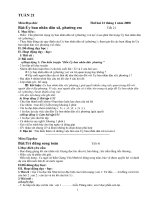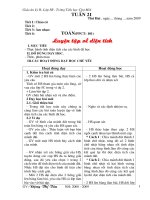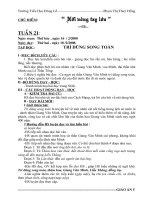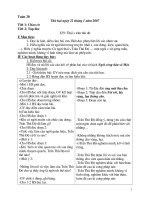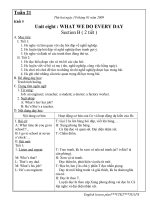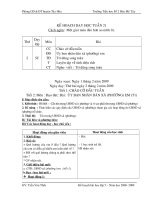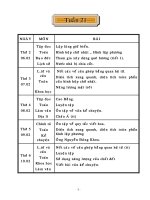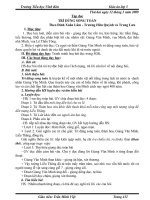ENGLISH 5- WEEK 21
Bạn đang xem bản rút gọn của tài liệu. Xem và tải ngay bản đầy đủ của tài liệu tại đây (127.94 KB, 15 trang )
<span class='text_page_counter'>(1)</span><div class='page_container' data-page=1>
<i><b>Date of preparation: 3/9/2017 </b></i>
<i><b>Week 21</b></i>
<i><b> </b></i>
<i><b>Period 81</b></i>
<b>UNIT 12: DON’T RIDE YOUR BIKE TOO FAST!</b>
<i><b>Lesson 3: Part 4-5-6</b></i>
<b>I. Objectives:</b>
<i><b>1.Knowledge: </b></i>
- By the end of the lesson, Ps will be able to use words and phrases related to the
topic accident preventation.
<i><b>2. Skills: </b></i>
- Develop Ps writing and listening skills
<i><b>3. Language focus:</b></i>
<b>- Vocabulary and structures:review</b>
<b>II. Teaching aids:</b>
<i>1. Teacher’s: student’s and teacher’s book, pictures, cassette.</i>
<i>2. Students’: books, notebooks, workbooks.</i>
<b>III. Teaching processes:</b>
<b>1. Class organzation:</b>
<b>Date of teaching</b> <b>Class</b> <b>Number of students</b>
<b>29/1/2018</b> <b>5A</b>
<b>30/1/2018</b> <b>5D</b>
<b>30/1/2018</b> <b>5C</b>
<b>31/1/2018</b> <b>5B</b>
<b>2.New lesson</b>
</div>
<span class='text_page_counter'>(2)</span><div class='page_container' data-page=2>
<b>I. Warm up:Spend a few minutes having the class say the </b>
<i>chant What’s the matter with you?</i>
<b>II. New lesson:</b>
<i><b>4. Read and do the tasks.</b></i>
<b>1. Circle the best title.</b>
• Tell the class that they are going to read the text and
circle the best title.
• Give them time to read the text and check their
comprehension. Give the meanings of
<i>common, accidents, sofa and tips, if necessary.</i>
• Set a time limit for them to do the task. Monitor the
activity and offer help, if necessary.
Key: b
<b>2. Tick True (T) or False (F).</b>
• Ask pupils to read the text again and tick the boxes.
• Set a time limit for them to do the task. Monitor the
activity and offer help, if necessary.
Key: 1 T 2 F 3 T 4 F 5 F
<i><b>5. Write what may happen.</b></i>
• Tell the class that they are going to write sentences about
accidents that may happen to Tony,
Linda and Quan.
• Give them time to read and do the task.
• Set a time limit for them to write sentences
- Read the chant
- Listen to the teacher
- Read the text
- Work in pairs
- Some Ps
- The whole class
</div>
<span class='text_page_counter'>(3)</span><div class='page_container' data-page=3>
independently. Monitor the activity and offer
help, if necessary.
• Get them to read their sentences in pairs before inviting
some pupils to read their answers
aloud.
<i>Key: Answers vary</i>
<i><b>6. Project</b></i>
• Tell the class that they are going to make a poster about
accidents at home and how to avoid
them.
• Have them work in groups. They should decide which
accidents to select and discuss how to avoid them. Ask
pupils to copy the table below and write notes in it. Then
ask them to illustrate their ideas on a poster.
<b>Accidents</b> <b>How to avoid the </b>
<b>accidents</b>
• Set a time limit for them to do the task.
• Select a few groups to present the results of their
discussions.
• If there is not enough time, give the project as
homework.
<b>7. Colour the stars.</b>
• Have the class read the statements and check their
- Work individually
- Some Ps read aloud the
answers
- Listen to the teacher
- Take note
- Do as directed
- Some Ps
- Listen
</div>
<span class='text_page_counter'>(4)</span><div class='page_container' data-page=4>
comprehension.
• Give them time to colour the stars and invite a few pupils
to read the statements aloud.
• Give further support to pupils who find it difficult to
achieve certain objectives.
<b>III. Consolidation</b>
- Summary the lesson
<b>IV. Homework</b>
- Do exercises in workbook, prepare the next period.
- Listen
- Remember
<i><b>Comment:</b></i>
<i><b>………</b></i>
<i><b>………</b></i>
<i><b>………</b></i>
<i><b>Date of preparation: 3/9/2017 </b></i>
<i><b>Week 21</b></i>
<i><b> </b></i>
<i><b>Period 82</b></i>
</div>
<span class='text_page_counter'>(5)</span><div class='page_container' data-page=5>
<b>I. Objectives:</b>
<i><b>1Knowledge: </b></i>
By the end of this unit, pupils can
<i>• use the words and phrases related to the topic free time activities.</i>
• ask and answer questions about what someone does in his/her free time, using
<i>What do</i>
<i>you do in your free time? I ...</i>
<i><b>2. Skills: </b></i>
- Develop Ps speaking and listening skills
<i><b>3. Language focus:</b></i>
<i>- Sentence Partners: What do you do in your free time? I ...</i>
- Vocabulary: free time, programme, do karate, surf…
<b>II. Teaching aids:</b>
<i>1. Teacher’s: student’s and teacher’s book, pictures, cassette.</i>
<i>2. Students’: books, notebooks, workbooks.</i>
<b>III. Teaching processes:</b>
<b>1. Class organzation:</b>
<b>Date of teaching</b> <b>Class</b> <b>Number of students</b>
<b>29/1/2018</b> <b>5A</b>
<b>30/1/2018</b> <b>5D</b>
<b>30/1/2018</b> <b>5C</b>
<b>31/1/2018</b> <b>5B</b>
<b>2.New lesson</b>
<b>Teacher’s activities</b> <b>Students’ activities</b>
</div>
<span class='text_page_counter'>(6)</span><div class='page_container' data-page=6>
<b>II. New lesson:</b>
<b>1. Look, listen and repeat.</b>
Tell the class that they are going to read a story in
which Nam and Tom talk about their free
time activities.
• Ask them to look at the pictures to identify the
<i>characters and ask them the questions Who are</i>
<i>they? Where are they? What’s Nam doing?</i>
<i>Explain the meanings of world and programme. </i>
Check comprehension.
• Play the recording all the way through for pupils to
listen and follow in their books. Play it
again for them to do choral and individual
repetition, pointing to the characters speaking.
• Check their understanding of the story.
<b>2.Point and say</b>
• Tell the class that they are going to practise asking
and answering questions about what
<i>someone does in his/her free time, using What do </i>
<i>you do in your free time? I ...</i>
• Have them look at the pictures and teach them the
<i>meaning of surf the Internet, go to the</i>
<i>cinema, clean the house and do karate. Then have </i>
them repeat the phrases once or twice.
• Get the class to practise saying what they do in
their free time, using words under the pictures.
- Look at the pictures and
answer:
- In Picture a, Tom is visiting
Nam’s house.
- In Picture b,
Tom wants to know what Nam
is doing.
-In Pictures c and d, they are
talking about what they
like doing in their free time,
<i>using Do you like ...? and What </i>
<i>do you do in your free time?)</i>
- Listen and copy
+ Listen and repeat
+ Groups, individuals
- Listen
</div>
<span class='text_page_counter'>(7)</span><div class='page_container' data-page=7>
<i>(E.g. I surf the Internet).</i>
<i>• Point to the first picture and ask What do you do in</i>
<i>your free time? for them to answer chorally</i>
and individually. Repeat the same procedure with
the rest of the pictures.
• Ask them to practise asking and answering the
question in pairs. Monitor the activity and
offer help, if necessary.
• Select some pairs to act out the exchanges.
<b>3. Let’s talk</b>
• Tell the class that they are going to practise asking
and answering questions about activities
in their free time. Get them to work in groups and
use the questions and answers in their
books.
• Set a time limit for them to practise. Monitor the
activity and offer help, if necessary.
• Select some pairs to act out the exchanges.
<b>III. Consolidation</b>
- Recall the main content.
<b>V. Homework:</b>
- Do exercises in workbook, learn by heart the new
words
- Do as directed
- Practise in pairs
+ Ask and answer questions
about activities
+ Practise in pairs
- Listen to the teacher
- Recall
- Remember
<i><b>Comment:</b></i>
</div>
<span class='text_page_counter'>(8)</span><div class='page_container' data-page=8>
<i><b>………</b></i>
<i><b>………</b></i>
<i><b>Date of preparation: 3/9/2017 </b></i>
<i><b>Week 21</b></i>
<i><b> </b></i>
<i><b>Period 83</b></i>
<b>UNIT 13: WHAT DO YOU DO IN YOUR FREE TIME?</b>
<i><b>Lesson 1: Part 4-5-6</b></i>
<b>I. Objectives:</b>
<i><b>1.Knowledge: </b></i>
By the end of this unit, pupils can
<i>• use the words and phrases related to the topic free time activities.</i>
• ask and answer questions about what someone does in his/her free time, using
<i>What do</i>
<i>you do in your free time? I ...</i>
<i><b>2. Skills: </b></i>
- Develop Ps speaking and listening skills
<i><b>3. Language focus:</b></i>
<b>- Vocabulary and structures: review</b>
<b>II. Teaching aids:</b>
</div>
<span class='text_page_counter'>(9)</span><div class='page_container' data-page=9>
<i>2. Students’: books, notebooks, workbooks.</i>
<b>III. Teaching processes:</b>
<b>1. Class organzation:</b>
<b>Date of teaching</b> <b>Class</b> <b>Number of students</b>
<b>31/1/2018</b> <b>5A</b>
<b>1/2/2018</b> <b>5D</b>
<b>1/2/2018</b> <b>5C</b>
<b>1/2/2018</b> <b>5B</b>
<b>2.New lesson</b>
Teacher’s activities Students’ activities
<i><b>I. Warm up: Play the game “jumbled letters”</b></i>
<b>II. New lesson:</b>
<i><b>4. Listen and tick</b></i>
• Tell the class that they are going to listen and tick the
right pictures.
• Ask them to look at the pictures and identify the
characters (1. Mary. 2. Linda. 3. Phong.) and
what they are doing in the pictures. Check understanding.
• Play the recording for pupils to listen. Play it again for
them to do the task.
• Get pupils to check their answers in pairs before checking
as a class. Play the recording again
to confirm the answers.
Key: 1 b 2 a 3 b
<i><b>5. Read and complete</b></i>
• Tell the class that they are going to read the text and
- Play the game
- Listen to the tape
- Listen and tick
- Answer the question.
</div>
<span class='text_page_counter'>(10)</span><div class='page_container' data-page=10>
complete the sentences.
• Give them a few seconds to read the text and the given
words. Remind them to focus on the
context to guess the words to fill the gaps.
• Set a time limit for them to do the task independently.
Monitor the activity and offer help, if
necessary.
• Get them to compare their answers in pairs before
checking as a class.
Key: 1 free 2 watch 3 go 4 Twice 5 songs
<b>6. Let’s play.</b>
• Tell the class that they are going to play a matching game.
• Divide the class into groups of ten. Give each pupil in
each group a piece of paper with one
<i>of the following words/phrases: go, surf, clean, play, </i>
<i>watch, cartoons, the Internet, badminton,</i>
<i>the room and to the cinema. When one pupil in the group </i>
<i>holds up the piece of paper with go</i>
and says the word aloud, the pupil who has the piece of
<i>paper with to the cinema holds it up</i>
and says the phrase aloud. The game continues until all the
pieces of paper are matched.
• Set a time limit for pupils to play the game. The group
that finishes the game the quickest
wins.
- Work Individually
- Do the task
- Do as directed
- Listen
</div>
<span class='text_page_counter'>(11)</span><div class='page_container' data-page=11>
<b>III. Consolidation</b>
- Retell the content of the lesson.
<b>IV. Homework</b>
- Do exercises in the workbook. Prepare the next period.
- Retell
- Remember
<i><b>Comment:</b></i>
<i><b>………</b></i>
<i><b>………</b></i>
<i><b>………</b></i>
<i><b>Date of preparation: 3/9/2017 </b></i>
<i><b>Week 21</b></i>
<i><b> </b></i>
<i><b>Period 84</b></i>
<b>UNIT 13: WHAT DO YOU DO IN YOUR FREE TIME?</b>
<i><b>Lesson 2: Part 1-2-3</b></i>
<b>I. Objectives:</b>
<i><b>1. Knowledge: </b></i>
By the end of this unit, pupils can
<i>• use the words and phrases related to the topic free time activities.</i>
• ask and answer questions about what a family member does in his/her free time,
using
<i>What does your ... do in his/her free time? He/She ...</i>
<i><b>.2. Skills: </b></i>
</div>
<span class='text_page_counter'>(12)</span><div class='page_container' data-page=12>
<i><b>3. Language focus:</b></i>
<i><b>- Vocabulary: question, survey, go camping, go fishing, go skating…</b></i>
<i>- Structures: What does your ... do in his/her free time? He/She ...</i>
<b>II. Teaching aids:</b>
<i>1. Teacher’s: student’s and teacher’s book, pictures, cassette.</i>
<i>2. Students’: books, notebooks, workbooks.</i>
<b>III. Teaching processes:</b>
<b>1. Class organzation:</b>
<b>Date of teaching</b> <b>Class</b> <b>Number of students</b>
<b>1/2/2018</b> <b>5A</b>
<b>2/2/2018</b> <b>5D</b>
<b>2/2/2018</b> <b>5B</b>
<b>2/2/2018</b> <b>5C</b>
<b>2.New lesson</b>
Teacher’s activities Students’ activities
<b>I. Warm up: Spend a few minutes having the class </b>
<i>play Pass the secret!, using the words learnt in</i>
Lesson 1. When the game is over, ask them to ask and
<i>answer the question What do you do in your</i>
<i>free time?, using the words in the game.</i>
<b>II. New lesson:</b>
<i><b>1. Look, listen and repeat</b></i>
• Tell the class that they are going to read a story about
Tony and Akiko. Tony is collecting information for
his survey. Ask pupils to look at the pictures and elicit
their answers to these
- Sing the song
- Look at the pictures and
answer:
(Tony and Akiko are in the
park.
</div>
<span class='text_page_counter'>(13)</span><div class='page_container' data-page=13>
<i>questions: Who are the characters in the pictures? </i>
<i>Where are they? What are they doing? </i>
• Play the recording all the way through for pupils to
listen and follow in their books. Play it
again for them to repeat line by line.
• Check their understanding of the story.
<i><b>2Point and say</b></i>
• Tell the class that they are going to practise asking
and answering questions about what their
<i>family members do in their free time, using What does</i>
<i>your ... do in his/her free time? He/She ...</i>
• Teach the phrases for activities under the pictures.
Ask pupils to practise saying the questions
<i>What does your ... do in his/her free time?, using the </i>
word for family members under each picture.
Then point at each picture and ask the question for
them to practise saying the answer.
• Ask pupils to practise asking and answering in pairs.
Monitor the activity and offer help, if
necessary.
his survey
and she agrees.
-In Picture b, he asks what she
does in her free time and she
says she watches
cartoons on TV.
-In Picture c, he goes on and
<i>asks How about your mother? </i>
<i>What does she do in her free </i>
<i>time? and Akiko answers She </i>
<i>goes shopping. </i>
<i>-In Picture d, Tony thanks </i>
Akiko.)
- Listen and copy
- Do as directed
- Listen
</div>
<span class='text_page_counter'>(14)</span><div class='page_container' data-page=14>
Select some pairs to act out the exchanges.
<i><b>3Let’s talk:</b></i>
• Tell the class that they are going to practise further
by asking and answering questions about
what their family members do in their free time.
• Get pupils to work in pairs and remind them to use
the questions and answers in their
books.
• Set a time limit for them to practise. Monitor the
activity and offer help, if necessary.
• Select some pairs to role-play the conversations in
front of the class.
<b> III. Consolidation:</b>
- Summary the lesson
<b>IV. Homework:</b>
- Do exercises in workbook, learn by heart the new
words
- Listen
- Work in pairs
- Some pairs perform in front
of class
- Listen to the teacher
- Remember
<i><b>Comment:</b></i>
</div>
<span class='text_page_counter'>(15)</span><div class='page_container' data-page=15></div>
<!--links-->
